Germany NOR Flash Market Size and Share
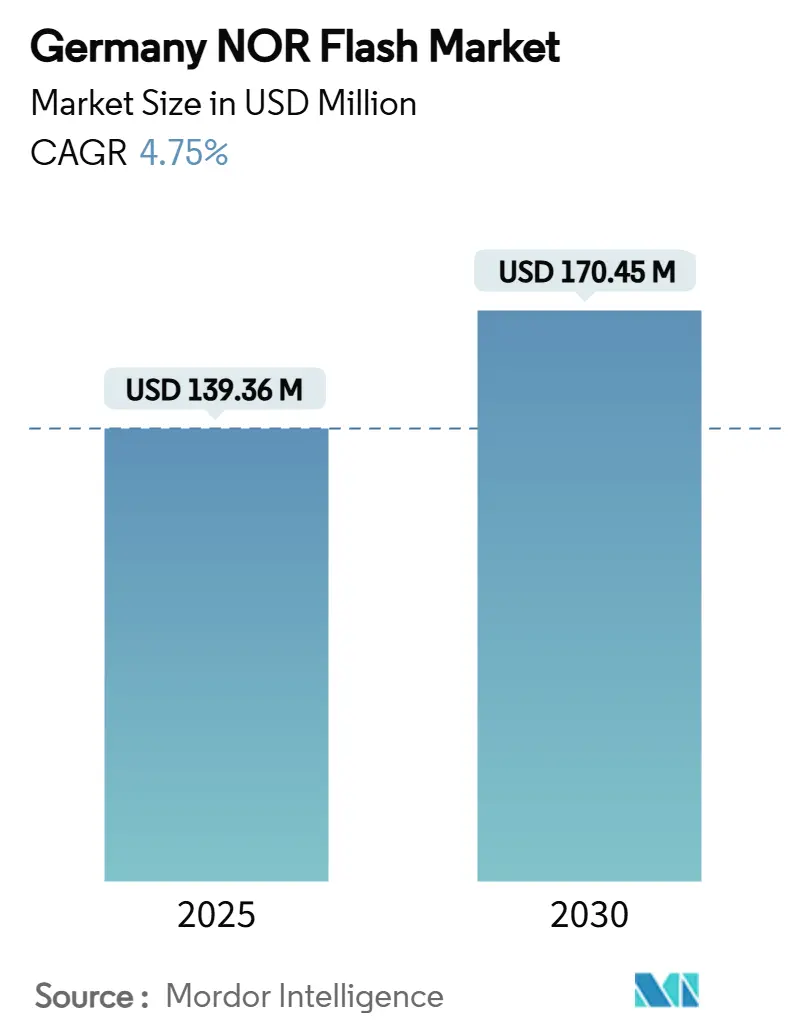
Germany NOR Flash Market Analysis by Mordor Intelligence
The Germany NOR Flash Market size is estimated at USD 139.36 million in 2025, and is expected to reach USD 170.45 million by 2030, at a CAGR of 4.75% during the forecast period. Sustained vehicle electrification, growth in Industrie 4.0 programs, and renewed investment in domestic semiconductor capacity underpin this expansion. Automotive electronic control units now embed larger code footprints, favouring NOR Flash for execute-in-place and fast-boot needs. Industrial IoT deployments demand secure, low-latency memory, pushing designers toward Octal/xSPI devices. Concurrently, the Bundesregierung’s EUR 4 billion (USD 4.13 billion) “Mikroelektronik” initiative has begun redirecting sourcing from offshore foundries to German fabs [1]Bundesministerium für Wirtschaft und Klimaschutz. "Mikroelektronik als Schlüsseltechnologie in Europa stärken." Accessed April 17, 2025. https://www.bmwk.de/Redaktion/DE/Artikel/Industrie/mikroelektronik.html. . The 55 nm process node dominates production, yet migration to 28 nm and below is accelerating to meet lower-power targets in safety-critical domains. Moderate supplier concentration leaves room for niche Asian entrants, but home-grown players are strengthening their foothold through functional-safety certification and local supply assurances.
Key Report Takeaways
- By type, Serial NOR captured 64.7% of Germany's NOR flash market share in 2024 while expanding at 5.7% CAGR through 2030.
- By interface, Octal/xSPI devices are projected to widen revenue 5.6% CAGR to 2030; Quad SPI dominated the market with 49.4% market share in 2024.
- By density, the 32-64 Mb band held 33.5% of Germany NOR flash market size in 2024; the 128-256 Mb tier is growing fastest at 5.8% CAGR to 2030.
- By voltage, 1.8 V parts led with 42.7% revenue in 2024; wide-voltage (1.65-3.6 V) solutions are rising 5.5% CAGR.
- By end-user, automotive commanded 45.7% market share in 2024, whereas industrial IoT logs the highest forecast CAGR at 5.9% to 2030.
- By process node, 55 nm devices retained a 47.7% share in 2024; the 28 nm and below class is set for an 5.2% CAGR on next-gen ECU demand.
- By packaging type, QFN/SOIC packages dominated the market with 53.8% of Germany NOR flash market share; WLCSP/CSP shipments are advancing at an 5.2% CAGR to 2030.
- Infineon, Winbond, Micron, Macronix, and GigaDevice together controlled more than 70% revenue in 2024.
Germany NOR Flash Market Trends and Insights
Drivers Impact Analysis
| Drivers | % Impact on CAGR Forecast | Geographic Relevance | Impact Timeline |
|---|---|---|---|
| Firmware-intensive ADAS and Domain Controllers Accelerating Automotive-grade NOR Demand | +2.10% | National, with concentration in Bavaria and Baden-Württemberg automotive clusters | Medium term (2-4 years) |
| Quad/Octal SPI Adoption for Fast-Boot IoT Edge Devices across German Manufacturing Hubs | +1.80% | National, with early gains in North Rhine-Westphalia and Saxony | Short term (≤ 2 years) |
| Constellation-Scale LEO Satellites Requiring Radiation-Hardened NOR Flash Devices | +0.90% | Limited to aerospace hubs in Bavaria and Bremen | Long term (≥ 4 years) |
| Bundesregierung's "Mikroelektronik" Funding Driving 55 nm and 40 nm On-shore Production for NOR Self-Sufficiency | +1.50% | Concentrated in Dresden and other eastern semiconductor clusters | Medium term (2-4 years) |
| Secure Boot and OTA-Update Mandates in Industrie 4.0 Factories | +1.20% | National, with early adoption in Baden-Württemberg and Bavaria | Short term (≤ 2 years) |
| Low-Power 1.8 V Serial NOR Enabling Wearable/Point-of-Care Healthcare Electronics | +0.70% | Urban centers with medical technology clusters | Medium term (2-4 years) |
| Source: Mordor Intelligence | |||
Firmware-intensive ADAS and domain controllers accelerating automotive-grade NOR demand
Vehicle zonal architectures raise per-car firmware needs from 64 Mb to 256 Mb, making high-density serial NOR vital for safety-critical boot code. Infineon’s SEMPER family achieved ASIL-D approval in May 2025, enabling Tier-1 suppliers to meet ISO 26262 requirements while keeping execute-in-place latency below 20 ns [2]Infineon Technologies AG. "Infineon SEMPER™ NOR Flash memory family achieves ASIL-D certification." May 8, 2025. https://www.infineon.com/cms/en/about-infineon/press/market-news/2025/INFATV202505-101.html. . German OEM roadmaps now specify 128-256 Mb NOR for domain controllers launching 2027-2028, ensuring a multi-year pull on automotive-grade supply.
Quad/Octal SPI adoption for fast-boot IoT edge devices across German manufacturing hubs
Factory controllers built on XMC7000 MCUs integrate six deterministic Ethernet protocols, reducing boot cycles from 2 s to 200 ms when paired with Octal SPI NOR running at 400 MB/s [3]Infineon Technologies AG. "Infineon and RT-Labs integrate six key industrial communication protocols in XMC7000 microcontroller." March 20, 2025. https://www.infineon.com/cms/en/about-infineon/press/market-news/2025/INFCSS202503-082.html. . North Rhine-Westphalia’s dense, discrete-manufacturing base is rolling these upgrades into retrofit lines, cutting downtime and meeting cyber-resilience mandates.
Constellation-scale LEO satellites requiring radiation-hardened NOR Flash devices
Commercial operators in Bavarian and Bremen aero-clusters adopt 512 Mbit QSPI parts hardened to 150 krad(Si), priced at 3-5× industrial ASP, yet essential for multi-year orbital missions [4]Infineon Technologies AG. "Infineon delivers industry's first radiation-hardened-by-design 512 Mbit QSPI NOR Flash memory for space and extreme environment applications." November 18, 2024. https://www.infineon.com/cms/en/about-infineon/press/market-news/2024/INFATV202411-024.html . Qualification cycles exceed 36 months, but order visibility stretches to the end of the decade, delivering steady high-margin volumes.
“Mikroelektronik” funding driving on-shore production for NOR self-sufficiency
EUR 4 billion (USD 4.63 billion) commitments under the German microelectronics program are underwriting 55 nm and 40 nm lines in Dresden, doubling local output share to 30% of domestic demand by 2030 [5]Bundesministerium für Wirtschaft und Klimaschutz. "Mikroelektronik als Schlüsseltechnologie in Europa stärken." Accessed April 17, 2025. https://www.bmwk.de/Redaktion/DE/Artikel/Industrie/mikroelektronik.html. . Automotive clients secure shorter lead times and geopolitical resilience, lifting demand for locally fabricated serial NOR with secure boot options.
Restraints Impact Analysis
| Restraint | % Impact on CAGR Forecast | Geographic Relevance |
|---|---|---|
| Cost Premium over NAND Above 256 Mb Limiting High-Density Consumer Adoption | -1.40% | National |
| Scaling Ceilings Beyond 45 nm Steering German OEM Roadmaps Toward MRAM/ReRAM Substitutes | -1.10% | National, with early impact in research-intensive regions |
| Foundry Concentration in Taiwan Exposing Supply-Chain Disruption Risk for German Tier-1s | -0.80% | National, with heightened concern among automotive suppliers |
| ASP Compression from Expanding Chinese Capacity Impacting Vendor Margins in Europe | -0.60% | National |
| Source: Mordor Intelligence | ||
Cost premium over NAND above 256 Mb limiting high-density consumer adoption
At 512 Mb, serial NOR costs 30%-35% more than SLC NAND, steering consumer device engineers toward NAND plus DRAM buffers even where execute-in-place would simplify PCB layouts. As 3D TLC NAND hits 2000 MT/s random read, mid-tier smartphone OEMs in Europe no longer budget for premium NOR.
Scaling ceilings beyond 45 nm steering German OEM roadmaps toward MRAM/ReRAM substitutes
Enterprise R&D teams at Aachen and Karlsruhe institutes confirm MRAM endurance past 1012 cycles versus NOR’s 106, while hitting 28 nm geometries on existing CMOS lines. Automotive technology councils are evaluating MRAM as a zonal firmware store beginning with 2029 platforms [6] University of Cambridge, “Emerging Non-Volatile Memories for Embedded Systems,” cam.ac.uk , trimming long-run NOR volumes.
Segment Analysis
By Type: Serial NOR consolidates leadership through interface and power advantages
Serial NOR held the majority of shares, equal to about 64.7% of the Germany NOR flash market. Interface simplicity saves up to 60 PCB pins, shrinking board area in ADAS cameras and industrial sensors. From 2025-2030, serial variants rise 5.7% CAGR as Tier-1s convert legacy parallel sockets to Octal/xSPI. This migration is most rapid in zonal gateways where power budgets tighten and deterministic wake-up must stay under 20 ms [7]Micron Technology. "NOR NAND Flash Guide." 2024. https://sg.micron.com/content/dam/micron/global/public/products/product-flyer/nor-nand-flash-guide.pdf.
Parallel NOR still powers legacy infotainment head units that require random access below 80 ns. Revenue continues to slip as infotainment suppliers redesign around high-density serial NOR or mixed NOR-NAND stacks that trim BOM cost and power draw. Yet satellite payload computers continue to specify parallel NOR for byte-wide access and extended radiation tolerance, keeping a stable niche revenue stream.
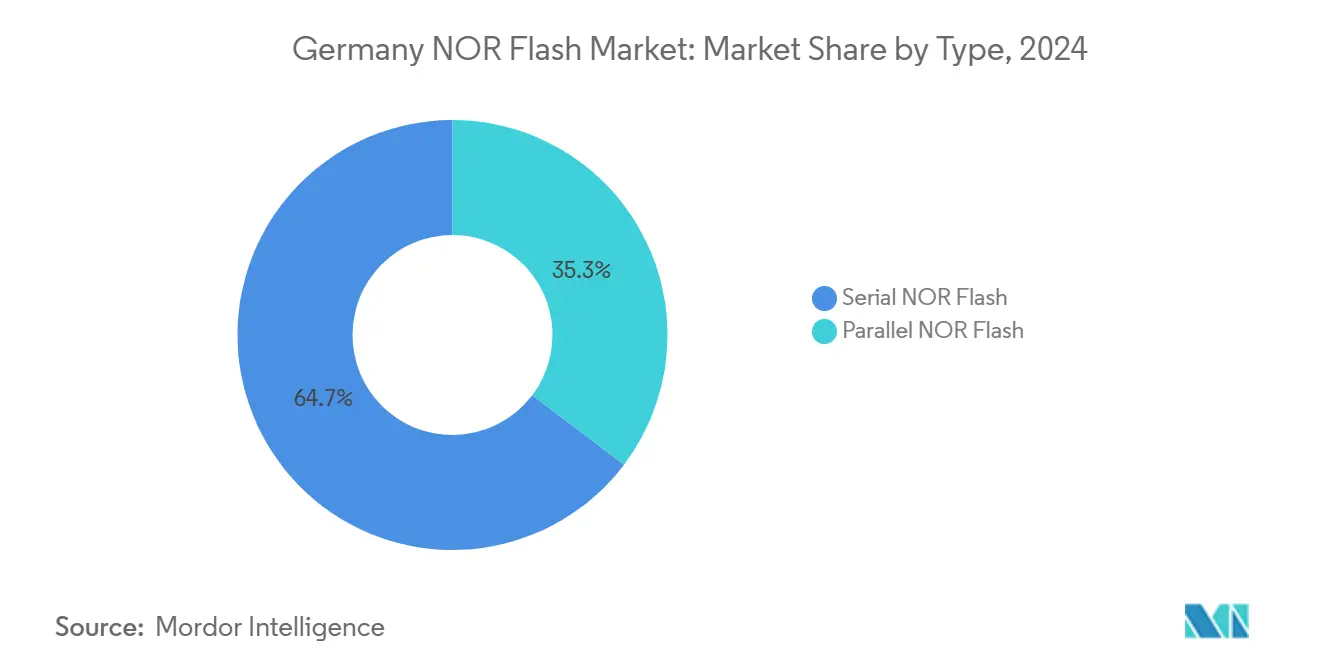
By Interface: Octal/xSPI captures performance-critical refresh cycles
Quad SPI devices dominated the market with 49.4% market share in 2024. Germany NOR flash market size in Octal/xSPI implementations is projected to expand at 5.6% CAGR by 2030. Automotive digital clusters adopt JEDEC xSPI to halve cold-boot times from 2 s to 900 ms. HyperBus-compatible NOR also enables dual-die stacking for up to 2 Gb densities without pin-count growth [8]Synopsys. "Optimizing xSPI for Flash Performance & Reliability." January 16, 2024. https://www.synopsys.com/articles/xspi-nor-flash-memory.html. .
Single/Dual SPI persists in ultralow-cost smart meters and white-goods controls, but unit demand weighs on gross margin. Interfaces older than Quad SPI shrink as 32-bit MCUs drop legacy flash controllers in favour of Octal DTR.
By Density: Mid-range reigns while high-end scales fastest
32-64 Mb shipments equating to 33.5% of Germany NOR flash market share in 2024. Automotive domain transition lifts average code size yearly, sustaining this band through 2030. However, the 128-256 Mb bracket races ahead at 5.8% CAGR, underpinned by LiDAR sensor fusion stacks needing larger over-the-air images [9]Infineon Technologies AG. "Infineon SEMPER™ NOR Flash memory family achieves ASIL-D certification." May 8, 2025. https://www.infineon.com/cms/en/about-infineon/press/market-news/2025/INFATV202505-101.html. .
Below-32 Mb usage fades as firmware complexity rises, trimming share significantly by 2030. Above-256 Mb densities edge up in aerospace and next-gen EV compute nodes, where deterministic latency still rules.
By Voltage: Flexibility shapes procurement preferences
1.8 V parts led with 42.7% revenue in 2024 for the Germany NOR flash Market. Designers favour the lower active current that extends battery life in medical wearables. Wide-voltage (1.65-3.6 V) devices, though smaller today, record 5.5% CAGR as OEMs trim SKU counts and inventory. Germany NOR flash market size for wide-voltage solutions is expected to grow significantly in the next five years.
Legacy 3 V categories remain in service for industrial controls retrofitted over decades. Suppliers keep them in production to honour long-lifecycle contracts, but the mix is expected to fall in the next few years.
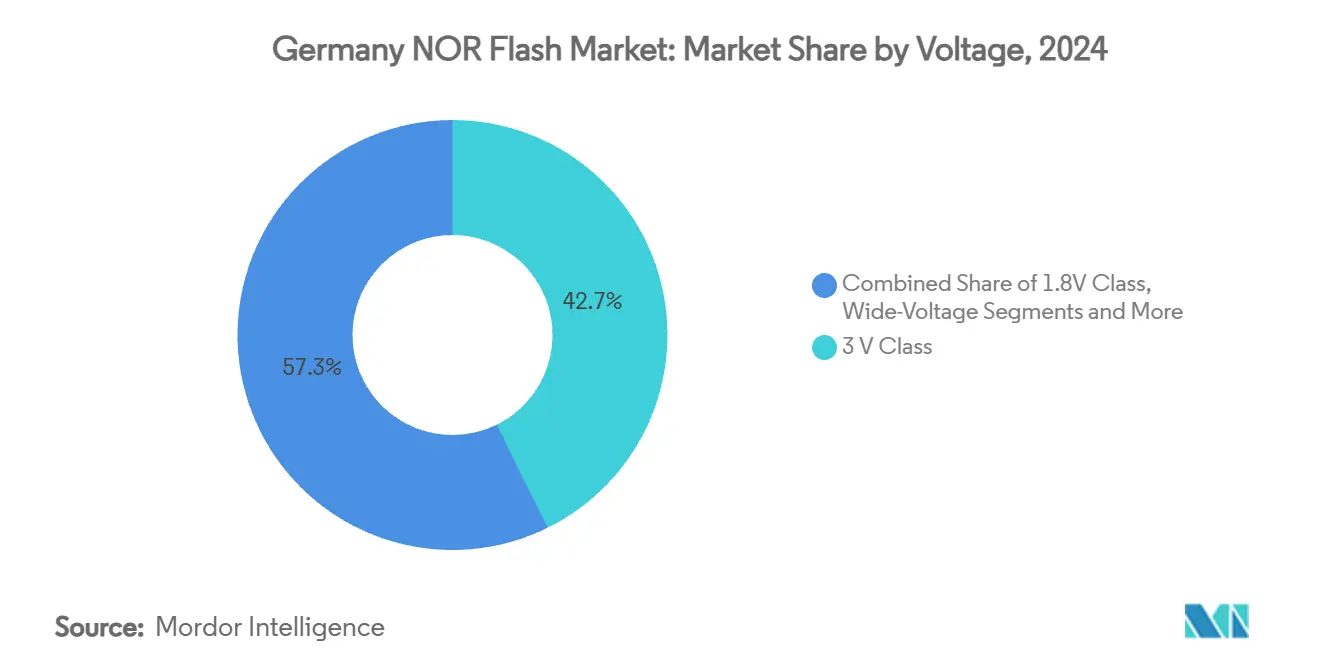
Note: Segment shares of all individual segments available upon report purchase
By End-user Application: Automotive anchors volume while industrial IoT accelerates
Automotive dominated the Germany NOR flash market with 45.7% market share in 2024. DO-254 and ISO 26262 compliance require qualified serial NOR, sustaining premium ASPs. Industrial IoT logs 5.9% CAGR as factories embrace secure firmware-writing over Ethernet, lifting demand for integrated AES-MAC NOR that silhouettes costly MCU changes.
Consumer electronics, communications, medical, and aerospace segments together hold 34% revenue. Within these, medical devices climb 5.5% CAGR on portable diagnostics, while satellite programmes push aerospace contribution significantly.
By Process Technology Node: Advanced geometry ramps despite 55 nm dominance
55 nm dominated the Germany NOR flash market with 47.7% market share in 2024. Foundries favour their mature photolithography and defectivity performance for automotive grade. Yet the 28 nm and below class is rising 5.2% CAGR, accelerating once TSMC’s N3A line qualifies for vehicle parts in late-2025. 65 nm stays relevant for price-sensitive meters; 45 nm fills a bridging role for high-reliability satellite parts, but manifold design starts go straight to 28 nm to future-proof roadmaps [10]TSMC. "Operational Highlights - TSMC Investor Relations." February 28, 2025. https://investor.tsmc.com/static/annualReports/2024/english/pdf/2024_tsmc_ar_e_ch5.pdf. .
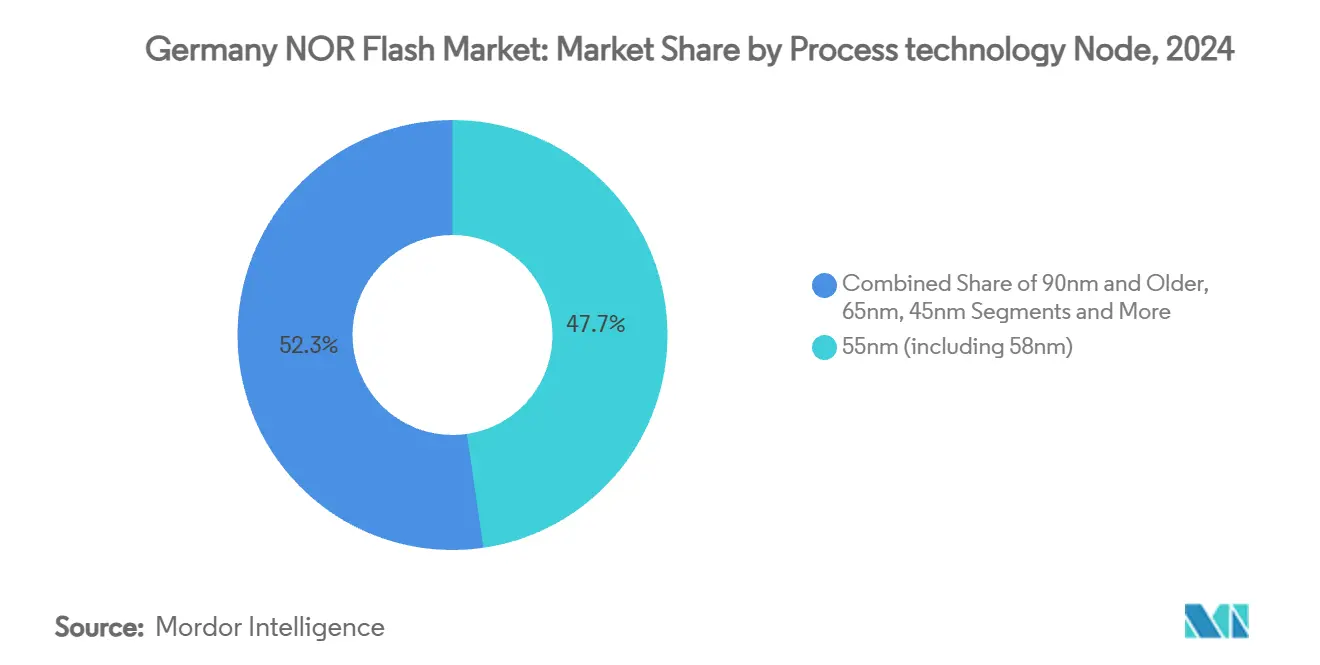
Note: Segment shares of all individual segments available upon report purchase
By Packaging Type: Miniaturization Drives CSP Growth Despite QFN Dominance
QFN/SOIC packages dominated the market with 53.8% of Germany's NOR flash market share, solidifying their position as the preferred choice for safety-critical automotive and industrial boards, primarily due to proven thermal performance and vibration robustness [11]Arrow Electronics. "Memory Guide - Arrow Electronics." Accessed April 17, 2025. https://static4.arrow.com/-/media/arrow/images/emea-campaigns/pemco-program/arr_broschuere_memoryguide_2108_interaktiv-nov2021.pdf. . Their entrenched qualification flow and low unit cost keep them the baseline option whenever designers prioritize reliability over footprint, ensuring QFN remains the anchor of Germany's NOR flash market size through at least 2028.
WLCSP/CSP shipments are advancing at a 5.2% CAGR, the fastest among package formats, as ADAS cameras, industrial sensors, and SiP modules demand up to 70% smaller footprints [12]Rutronik. "NOR Flash Safety for Automotive & Industrial Innovations." Accessed April 17, 2025. https://www.rutronik.com/article/nor-flash-safety-for-automotive-and-industrial-innovations. . Although BGA/FBGA still dominate high-density (greater than 128 Mb) subsystems that need elevated pin counts, their complex assembly dampens uptake in cost-sensitive gear. Ongoing stacked-die innovations enable further density gains without enlarging footprints, a trend reflected in GigaDevice’s latest automotive Flash portfolio [13]GigaDevice. "GigaDevice to showcase innovations for accelerated IOT and automotive sectors at Electronica 2024." November 12, 2024. https://www.gigadevice.com/about/news-and-event/news/gigadevice-to-showcase-innovations-at-electronica-2024. .
Geography Analysis
Bavaria and Baden-Württemberg account for over 55% of domestic consumption, driven by OEMs such as BMW, Mercedes-Benz, and Tier-1 suppliers clustered along the automotive corridor. Octal/xSPI adoption here leads national averages by two years, shaving ADAS boot sequences to sub-second thresholds [14]Synopsys. "Optimizing xSPI for Flash Performance & Reliability." January 16, 2024. https://www.synopsys.com/articles/xspi-nor-flash-memory.html. . Infineon’s Neubiberg HQ speeds co-development cycles, enabling device qualification within 12 months versus 18 months previously.
Saxony’s Dresden hub anchors on-shore fabrication. The Smart Power Fab—funded in May 2025—targets an annual capacity of 11 billion chips, a portion allocated to automotive-grade NOR at 55 nm and 40 nm [15]Infineon Technologies AG. "German government issues final funding approval for new Infineon ..." May 8, 2025. https://www.infineon.com/cms/en/about-infineon/press/press-releases/2025/INFXX202505-100.html. . This scaling feeds eastern German suppliers, tapering reliance on Asian foundries.
North Rhine-Westphalia leads industrial IoT memory demand. Its machine tools sector embeds secure boot serial NOR to satisfy IEC 62443 audits, while connection to Ruhr’s logistics backbone accelerates component flow. Federal digital-innovation grants have also lured med-tech startups into Cologne-Düsseldorf, boosting orders for 1.8 V NOR parts.
Competitive Landscape
The supplier field remains moderately concentrated. Infineon controls a significant share of revenue through a strong domestic fab presence and ASIL-D certified SEMPER line, positioning it as the default for German ADAS ECU launches. Winbond also holds a significant share by outselling in mid-density (32-128 Mb) automotive sockets, leaning on AEC-Q100 grade plus lengthy longevity roadmaps.
Micron’s shares in the market are rooted in high-density (≥512 Mb) parallel NOR used in telecom infrastructure and military avionics, while Macronix garners its market share via radiation-tolerant Octal SPI parts, winning European Space Agency grants. GigaDevice is claiming growth in the market through aggressively priced GD25LT/LX serial portfolio, recently qualified by German Tier-1 suppliers [16]GigaDevice. "GigaDevice: An Innovator of Memory Designs Brings in High ..." Accessed April 17, 2025. https://www.nxp.com/design/design-center/training/TIP-CONNECTS2021-ENT505. .
The Bundesregierung’s sovereignty agenda tilts sourcing toward European-based manufacture. Local fabs gain preference points in OEM RFQs, prompting Asian suppliers to negotiate joint ventures or licensing to retain share. Security functionality differentiation intensifies: Infineon bundles hardware root-of-trust, Macronix embeds secure key storage, and Winbond offers dual-die redundancy for functional safety.
Strategic playbooks now emphasise interface speed and certification pedigree. Vendors race to deliver 400 MB/s Octal DTR parts with built-in ECC and AES-256. Market entrants lacking xSPI roadmaps or ISO 26262 artefacts face disqualification at the RFQ stage.
Germany NOR Flash Industry Leaders
-
Winbond Electronics Corporation
-
Macronix International Co. Ltd.
-
GigaDevice Semiconductor Inc.
-
Infineon Technologies AG
-
Micron Technology Inc.
- *Disclaimer: Major Players sorted in no particular order
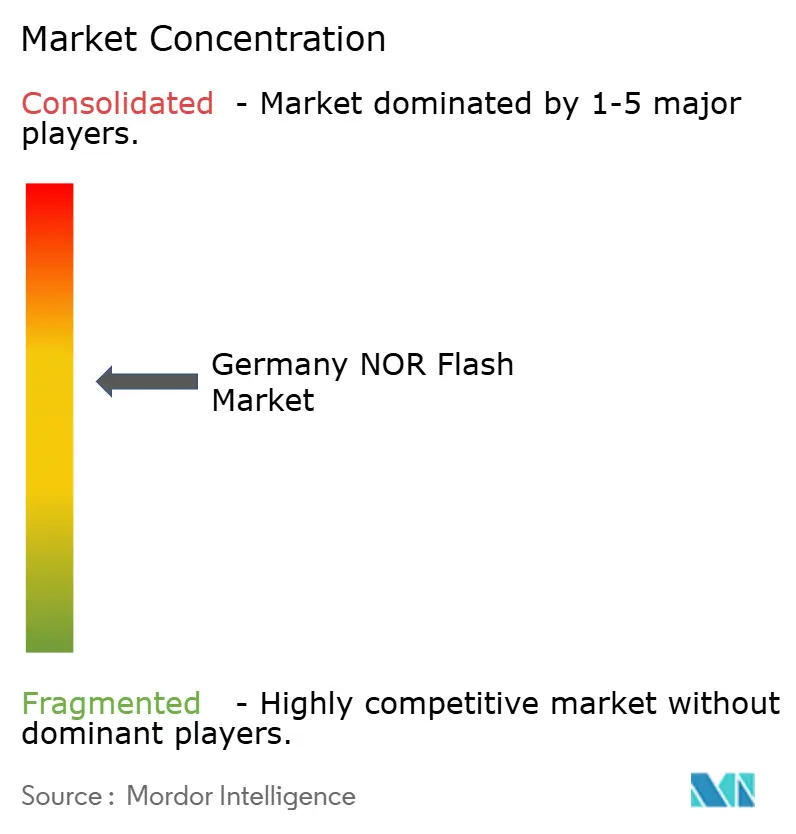
Recent Industry Developments
- January 2025: Infineon achieved ASIL-D certification for the SEMPER NOR portfolio covering densities 256 Mb- 2 Gb, strengthening its grip on safety-critical automotive ECUs. The move aligns with OEM demand for ISO 26262 compliance and lowers validation time for Tier-1s.
- January 2025: Infineon received final federal funding to construct the USD 5 billion Smart Power Fab in Dresden, targeting 55 nm-40 nm automotive devices and adding 1,000 skilled jobs. The investment secures local supply resiliency and feeds regional demand.
- April 2025: Infineon and Marelli formed a partnership to integrate MEMS laser beam scanning into cockpit displays, leveraging Infineon’s optics driver ICs and expanding NOR Flash attach rates in digital clusters.
- April 2025: Infineon introduced CoolSiC MOSFET 750 V G2, improving power density in EV chargers; new boards will bundle higher-speed xSPI NOR for faster firmware updates.
Research Methodology Framework and Report Scope
Market Definitions and Key Coverage
Our study defines the German NOR flash memory market as the invoiced value of newly manufactured serial and parallel NOR chips shipped to domestic OEM, ODM, and distributor channels across automotive, industrial, consumer, communication, and other end uses. Values are expressed in constant 2024 USD.
Scope exclusion: We exclude NOR blocks embedded inside system-on-chips or evaluation boards and any refurbished or gray-market inventory.
Segmentation Overview
- By Type (Value and Volume)
- Serial NOR Flash
- Parallel NOR Flash
- By Interface (Value)
- SPI Single / Dual
- Quad SPI
- Octal and xSPI
- By Density (Value)
- 2 Megabit And Less NOR
- 4 Megabit And Less-NOR (greater than 2mb) NOR
- 8 Megabit And Less (greater than 4mb) NOR
- 16 Megabit And Less (greater than 8mb) NOR
- 32 Megabit And Less (greater than 16mb) NOR
- 64 Megabit And Less (greater than 32mb) NOR
- 128 Megabit and Less (greater than 64MB) NOR
- 256 Megabit and Less (greater than 128MB) NOR
- Greater than 256 Megabit
- By Voltage (Value)
- 3 V Class
- 1.8 V Class
- Wide-Voltage (1.65 V – 3.6 V)
- Others - 1.2V Class (and similar sub-1.8V) (2.5V, 5V, etc.)
- By End-user Application (Value and Volume)
- Consumer Electronics
- Communication
- Automotive
- Industrial
- Other Applications
- By Process Technology Node (Value)
- 90 nm and Older
- 65 nm
- 55 nm (including 58 nm)
- 45 nm
- 28 nm and Below
- By Packaging Type (Value)
- WLCSP / CSP
- QFN / SOIC
- BGA / FBGA
- Others
Detailed Research Methodology and Data Validation
Primary Research
We interviewed purchasing heads at Tier-1 auto suppliers, EMS buyers, and memory distributors in Bavaria, Saxony, and NRW, and ran short surveys with IoT start-ups. Their feedback confirmed live ASP brackets, density roadmaps, and interface changeover dates that we fed into the model.
Desk Research
We began with tier-one public datasets such as Statistisches Bundesamt trade codes, KBA vehicle output, ACEA EV registrations, VDMA semiconductor machinery indices, and patent families mined through Questel, which together revealed unit flows, density shifts, and production ramp timing.
Our team then screened company filings, Infineon expansion releases, and trade press archived in Dow Jones Factiva and D&B Hoovers, aligning ASP commentary with shipment tallies.
The sources named illustrate, not exhaust, the wider set consulted during data collection.
Market-Sizing & Forecasting
We apply a top-down construct: domestic production, imports, and re-export volumes are reconstructed, adjusted for capacity utilization, and multiplied by verified ASP ranges; selective bottom-up rollups of vendor invoices validate totals. Key variables include EV assembly volume, Industrie 4.0 controller shipments, average code size per ECU, interface-mix shares, and density migration rates. A multivariate regression with ARIMA overlays produces the 2025-2030 outlook, and gaps are bridged with moving-average interpolation agreed upon during interviews.
Data Validation & Update Cycle
Before sign-off, Mordor analysts run variance dashboards against customs data and trade indices, re-contacting sources when deviations exceed two standard deviations. We refresh the model annually and issue interim updates for material fab or policy events.
Why Mordor's Germany NOR Flash Baseline Earns Trust
We acknowledge that published estimates often diverge because firms cherry-pick chip types, use different FX dates, or project densities with optimistic yield curves.
Mordor counts only traceable, freshly produced chips, applies monthly Bundesbank rates, and refreshes every twelve months, whereas other publishers fold in refurbished supply or broad flash categories, inflating totals.
Benchmark comparison
| Market Size | Anonymized source | Primary gap driver |
|---|---|---|
| USD 139.36 M (2025) | Mordor Intelligence | - |
| USD 245.8 M (2024) | Regional Consultancy A | Serial NOR only, national sales up-scaled via smartphone penetration |
| USD 2.8 B (2025) | Industry Blog B | Groups all non-volatile codes under NOR customs headings |
| USD 5.78 B (2024) | Trade Journal C | Adds embedded NOR in SoCs and speculative fab output |
Overall, we believe Mordor's disciplined scope selection, transparent variables, and frequent refreshes deliver a balanced, repeatable baseline that decision makers can rely upon.
Key Questions Answered in the Report
What is the projected size of the Germany NOR flash market by 2030?
The market is forecast to reach USD 183.6 million in 2030, expanding at a 6.2% CAGR from 2025.
Which end-user segment represents the largest share today?
Automotive applications hold 45.7% of revenue, led by ADAS and domain controllers that rely on fast execute-in-place memory.
Why are Octal/xSPI interfaces gaining popularity?
They deliver up to 400 MB/s bandwidth, cutting boot times in safety-critical systems and supporting larger OTA firmware images, driving 9.1% CAGR growth.
Which density range is growing fastest and why?
The 128-256 Mb segment posts 10.8% CAGR as zonal vehicle architectures and advanced ADAS stacks demand larger code storage.
Page last updated on:



